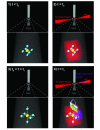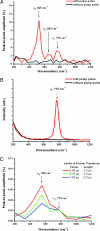Monitoring molecular dynamics using coherent electrons from high harmonic generation
- PMID: 16895984
- PMCID: PMC1533881
- DOI: 10.1073/pnas.0605178103
Monitoring molecular dynamics using coherent electrons from high harmonic generation
Abstract
We report a previously undescribed spectroscopic probe that makes use of electrons rescattered during the process of high-order harmonic generation. We excite coherent vibrations in SF(6) using impulsive stimulated Raman scattering with a short laser pulse. A second, more intense laser pulse generates high-order harmonics of the fundamental laser, at wavelengths of approximately 20-50 nm. The high-order harmonic yield is observed to oscillate, at frequencies corresponding to all of the Raman-active modes of SF(6), with an asymmetric mode most visible. The data also show evidence of relaxation dynamics after impulsive excitation of the molecule. Theoretical modeling indicates that the high harmonic yield should be modulated by both Raman and infrared-active vibrational modes. Our results indicate that high harmonic generation is a very sensitive probe of vibrational dynamics and may yield more information simultaneously than conventional ultrafast spectroscopic techniques. Because the de Broglie wavelength of the recolliding electron is on the order of interatomic distances, i.e., approximately 1.5 A, small changes in the shape of the molecule lead to large changes in the high harmonic yield. This work therefore demonstrates a previously undescribed spectroscopic technique for probing ultrafast internal dynamics in molecules and, in particular, on the chemically important ground-state potential surface.
Conflict of interest statement
Conflict of interest statement: No conflicts declared.
Figures






Comment in
- Proc Natl Acad Sci U S A. 103:13276.
Similar articles
-
Dynamic imaging of molecules using high order harmonic generation.Phys Chem Chem Phys. 2008 Jan 7;10(1):35-48. doi: 10.1039/b714126m. Epub 2007 Nov 14. Phys Chem Chem Phys. 2008. PMID: 18075681 Review.
-
Ultrafast time-resolved pump-probe spectroscopy of PYP by a sub-8 fs pulse laser at 400 nm.J Phys Chem B. 2013 May 2;117(17):4818-26. doi: 10.1021/jp4001016. Epub 2013 Apr 11. J Phys Chem B. 2013. PMID: 23534531
-
Coherent high-order harmonic generation by sawtooth-like laser fields.Opt Express. 2013 May 6;21(9):11270-5. doi: 10.1364/OE.21.011270. Opt Express. 2013. PMID: 23669984
-
Theoretical exploration of control factors for the high-order harmonic generation (HHG) spectrum in two-color field.Spectrochim Acta A Mol Biomol Spectrosc. 2014 Sep 15;130:19-23. doi: 10.1016/j.saa.2014.03.098. Epub 2014 Apr 2. Spectrochim Acta A Mol Biomol Spectrosc. 2014. PMID: 24759780
-
Probing electronic dynamics during photochemical reactions.Chimia (Aarau). 2013;67(4):207-12. doi: 10.2533/chimia.2013.207. Chimia (Aarau). 2013. PMID: 23967690 Review.
Cited by
-
Following a chemical reaction using high-harmonic interferometry.Nature. 2010 Jul 29;466(7306):604-7. doi: 10.1038/nature09185. Nature. 2010. PMID: 20671706
-
In situ monitoring of molecular aggregation using circular dichroism.Nat Commun. 2018 Nov 23;9(1):4961. doi: 10.1038/s41467-018-07299-3. Nat Commun. 2018. PMID: 30470749 Free PMC article.
-
Probing phonon dynamics with multidimensional high harmonic carrier-envelope-phase spectroscopy.Proc Natl Acad Sci U S A. 2022 Jun 21;119(25):e2204219119. doi: 10.1073/pnas.2204219119. Epub 2022 Jun 15. Proc Natl Acad Sci U S A. 2022. PMID: 35704757 Free PMC article.
-
Toward an Understanding of the Pressure Effect on the Intramolecular Vibrational Frequencies of Sulfur Hexafluoride.J Phys Chem A. 2021 Jul 29;125(29):6362-6373. doi: 10.1021/acs.jpca.1c02595. Epub 2021 Jul 15. J Phys Chem A. 2021. PMID: 34263605 Free PMC article.
-
Phase matching of high harmonic generation in the soft and hard X-ray regions of the spectrum.Proc Natl Acad Sci U S A. 2009 Jun 30;106(26):10516-21. doi: 10.1073/pnas.0903748106. Epub 2009 Jun 18. Proc Natl Acad Sci U S A. 2009. PMID: 19541611 Free PMC article.
References
-
- Zewail A. H. J. Phys. Chem. A. 2000;104:5660–5694.
-
- Zewail A. H. Sci. Am. 1990;263(6):40–46. - PubMed
-
- Bardeen C. J., Wang Q., Shank C. V. J. Phys. Chem. A. 1998;102:2759–2766.
-
- Chang Z. H., Rundquist A., Wang H. W., Murnane M. M., Kapteyn H. C. Phys. Rev. Lett. 1997;79:2967–2970.
-
- Murnane M. M., Kapteyn H. C., Rosen M. D., Falcone R. W. Science. 1991;251:531–536. - PubMed
Publication types
MeSH terms
Substances
LinkOut - more resources
Full Text Sources

